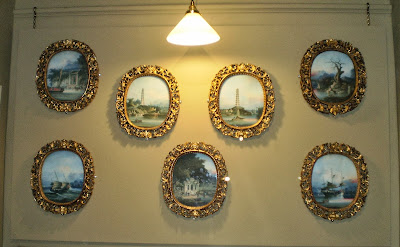Amongst the generous bequest to Leeds from Sir Alvary and Lady Gascoigne are this group of seven oil paintings, received in 1971. They are all show scenes from the Canton region, and they are all in similar oval frames, with outside dimensions of 280mm height and 236mm width. In 2007, when David Beevers from the Royal Pavilion in Brighton visited Leeds during research for their Chinese Whispers exhibition, he saw these paintings and helped us by asking Patrick Conner for his opinion. Patrick is a Chinese paintings expert at the firm of Martyn Gregory in London. His comments have been really useful as we prepared for the current Chinese Paintings exhibition at Lotherton Hall. He wrote:
'They are all (as you know) Cantonese 'export' paintings of c. 1850, in a style often associated with an artist known to Westerners as Namcheong. The temple scenes do not represent any particular temple, so far as anyone has ever discovered, but the pagoda is at Whampoa (modern Huangbu), a dozen miles from the city of Canton (Guangzhou) : it would have been very familiar to the crews of the Western ships who were obliged to anchor alongside Whampoa Island for several months at a time!.. The remarkable thing about the group is not the paintings but the frames. From the colour of the gilding and the sharp carving of flowers etc they look as if they could be Chinese too, in which case I've never seen anything quite like them. If they are Cantonese, they will be light (Chinese pine), and the Chinese carpentry should be obvious from the back.'
Jenny Hack, our paintings conservator at Leeds, had already investigated one of the paintings, and revealed its canvas support. Ian Fraser, the furniture conservator, was also intrigued by the wooden frames. He agrees that they are Oriental, but maybe Japanese rather than Chinese. We do hope to analyse the wood scientifically in the future.
An essay by Peter C. Perdue in the MIT Visualizing Culture series, available online, allows us to compare several other Whampoa pagoda paintings with the two at Leeds. The essay is entitled the ‘Rise and Fall of the Canton Trade System – II, Macau and Whampoa Anchorage’ and is available at http://ocw.mit.edu/ans7870/21f/21f.027/rise_fall_canton_01/pdf/cw02_essay04.pdf. The closest painting in style to ours is one credited as “The Nine-Stage Pagoda at Whampoa Anchorage”, unknown Chinese artist, ca. 1830–50, [cwBTW_1830-50_Whampoa].
Looking closely at the paintings you can almost read the characters on the red festival banners hanging either side of the door in this work. Maybe the sampan owners have come to help with a major celebration.
We have also noticed that the triple moon windows in the memorial gate in this painting, are echoed in a modern way in the architecture plans for the new Guangzhou Art Museum.
In the Leeds collections we have a large model junk that would match up well with one of the paintings.
It is currently on show in the 'Fate and Fickle Fortune' exhibiton at Abbey House, for visitors to admire the lucky eyes on the prows. Another key item in the Leeds collections, reflecting the importance of the Canton trade, is this 18th century punch bowl featuring the European trade factories of Canton, very similar to the one at the Peabody Museum, Essex. The Leeds bowl (LEEAG.CE.1967.24.29), is painted in fine grisaille detail, with a view of the East India Company ship, Pitt, in the centre.
Hopefully more images of these Chinese export trade items will be available on our own collections website next year, as we are undergoing a major revamp at the moment.
Antonia Lovelace (Curator of World Cultures) and Estelle Wu (intern)
Antonia Lovelace (Curator of World Cultures) and Estelle Wu (intern)











